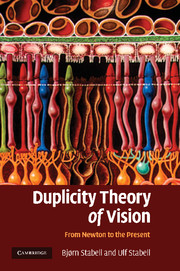Book contents
- Frontmatter
- Contents
- Acknowledgements
- 1 Introduction
- Part I The development of the basic ideas of the duplicity theory from Newton to G. E. Müller
- Part II The development of the duplicity theory from 1930–1966
- Part III Chromatic rod vision: a historical account
- Part IV Theories of sensitivity regulation of the rod and cone systems: a historical account
- 15 Introduction
- 16 Early photochemical explanations
- 17 Contribution of S. Hecht
- 18 Contribution of G. Wald: photochemical sensitivity regulation mechanisms of rods and cones
- 19 Relationship between amount of rhodopsin and sensitivity during dark adaptation
- 20 Post-receptor sensitivity regulation mechanisms
- 21 Rushton's AGC model
- 22 Contribution of H.B. Barlow
- 23 Rushton and Barlow compared
- 24 The Dowling-Rushton equation refuted
- 25 Several mechanisms involved in sensitivity regulation
- 26 Sensitivity regulation due to rod-cone interaction
- 27 Modern conceptions of sensitivity regulation
- Part V Factors that triggered the paradigm shifts in the development of the duplicity theory
- References
- Index
22 - Contribution of H.B. Barlow
Published online by Cambridge University Press: 22 January 2010
- Frontmatter
- Contents
- Acknowledgements
- 1 Introduction
- Part I The development of the basic ideas of the duplicity theory from Newton to G. E. Müller
- Part II The development of the duplicity theory from 1930–1966
- Part III Chromatic rod vision: a historical account
- Part IV Theories of sensitivity regulation of the rod and cone systems: a historical account
- 15 Introduction
- 16 Early photochemical explanations
- 17 Contribution of S. Hecht
- 18 Contribution of G. Wald: photochemical sensitivity regulation mechanisms of rods and cones
- 19 Relationship between amount of rhodopsin and sensitivity during dark adaptation
- 20 Post-receptor sensitivity regulation mechanisms
- 21 Rushton's AGC model
- 22 Contribution of H.B. Barlow
- 23 Rushton and Barlow compared
- 24 The Dowling-Rushton equation refuted
- 25 Several mechanisms involved in sensitivity regulation
- 26 Sensitivity regulation due to rod-cone interaction
- 27 Modern conceptions of sensitivity regulation
- Part V Factors that triggered the paradigm shifts in the development of the duplicity theory
- References
- Index
Summary
DARK AND LIGHT ADAPTATION BASED ON SIMILAR MECHANISMS
In contrast to the assumption of Rushton that light and dark adaptation were determined by quite different mechanisms, Barlow (1964) put forward the hypothesis that their underlying mechanisms were very similar; that the sensitivity regulation during dark adaptation was mainly determined by so-called 'photon-like' events. Thus, he presumed that the presence of bleached photopigment caused the receptors to show effects similar to those induced by light. Both the bleached photopigments and light increased the intrinsic noise level of the receptors. In fact, the effect of bleached pigments was assumed to add to that of light so that the separate effects of the two factors could not be distinguished at the receptor output.
BOTH NOISE AND NEURAL MECHANISMS INVOLVED
There was, however, a serious obstacle to Barlow's noise theory, since the expected square root law was not fulfilled in incremental threshold measurements. Thus, if a light flooding the retina elevated the threshold solely by virtue of the intrinsic noise level of receptors (i.e. the statistical fluctuation in the number of quanta absorbed) the incremental threshold should rise in proportion to the square root of the intensity of the flooding light (see De Vries, 1943; Rose, 1953; Barlow, 1957). Opposed to this prediction, however, it had been found that, over a large range of background intensities, the incremental threshold for a large test field rose in direct proportion to the background intensity (the Weber law).
- Type
- Chapter
- Information
- Duplicity Theory of VisionFrom Newton to the Present, pp. 169 - 173Publisher: Cambridge University PressPrint publication year: 2009



